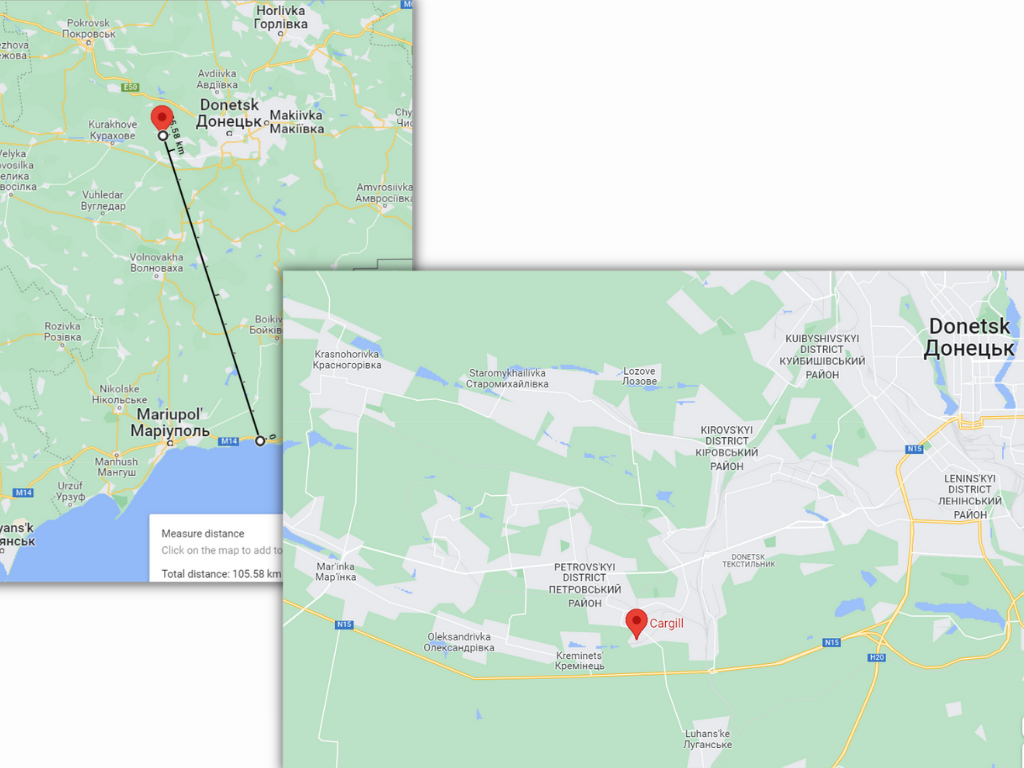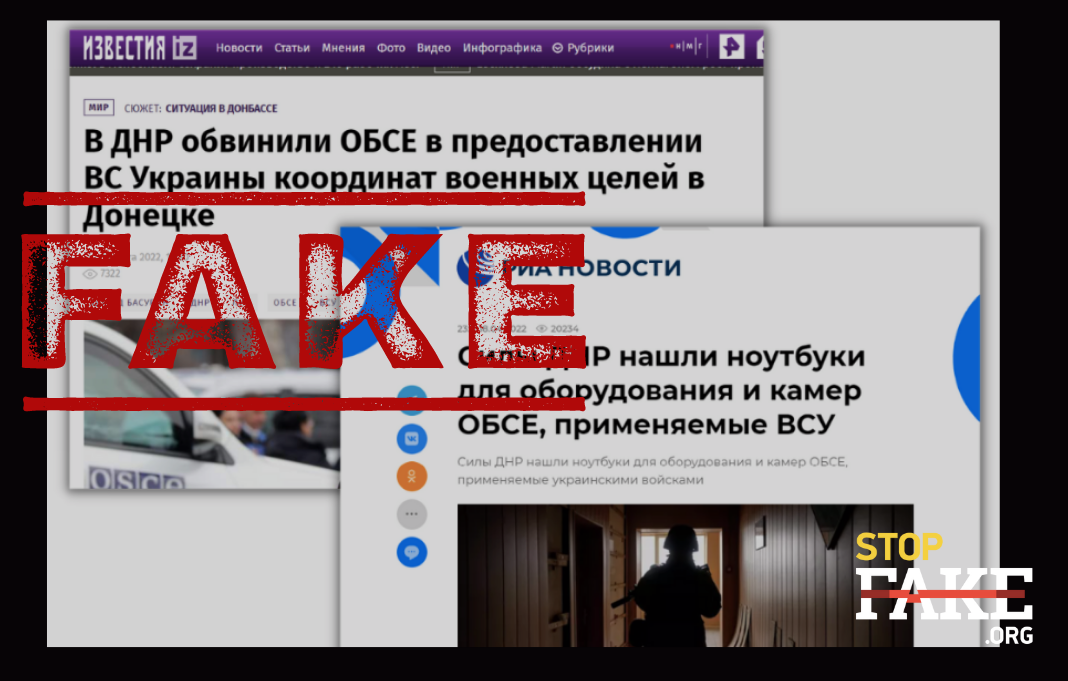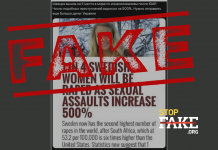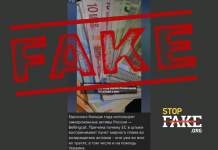Accusations that the OSCE provided Ukrainian Armed Forces with coordinates of military targets obtained through its video cameras are unfounded. StopFake found obvious inconsistencies in Russian media stories on the subject. For one, the video footage offered as “material evidence” was taken in a different area long before the beginning of Russia’s full-scale invasion of Ukraine. In addition, the OSCE cameras in question were incapable of recording video at long distances; for this purpose UAVs would have been used.
Russian media accused the Organization on Security and Cooperating in Europe (OSCE) of sharing, with the the Armed Forces of Ukraine, data on the location of Russian forces, allowing them to correct artillery strikes. According to Russian media, the OSCE’s Special Monitoring Mission (SMM) provided the Ukrainian military with data from its video surveillance cameras. Their stories claimed “material evidence” “proved” these accusations. In effect, Russian propagandists are trying to convince everyone that the OSCE carried out subversive activities in Donbas.
Kremlin authorities and the so-called Donetsk People’s Republic (DNR) and the Luhansk People’s Republic (LNR) have had strained relations from the very beginning with the OSCE SMM, which has been working in Ukraine since March 21, 2014. And since the signing of the Minsk 2 agreement in February 2015, the Special Monitoring Mission has been the independent party that monitored the implementation of the commitments to ceasefire and the withdrawal of weapons from the demarcation line. Russia’s hybrid forces in Donbas, however, regularly obstructed the activities of SMM representatives on territory not controlled by Ukraine, something the mission repeatedly recorded in its reports. In February 2022, before the start of Russia’s full-scale invasion of Ukraine, the SMM reported numerous cases of ceasefire violations by Russian and proxy forces. On February 25, the OSCE evacuated all its monitors from Ukraine. On March 31, 2022, the mandate of the SMM in the Donbas expired.

On March 1 a representative of the “People’s Militia” of the DNR, Eduard Basurin, claimed that OSCE representatives might have transmitted coordinates of military targets in Donetsk to the Armed Forces of Ukraine. DNR officials alluded to the presence of documents allegedly indicating coordinates of military targets provided by the SMM to Ukrainian forces. Major Russian propaganda outlets – Izvestia, RT, TASS, Gazeta.ru, RIA Novosti, Rossiya 1, Zvezda, and others – published these accusations against the SMM. Subsequently, on April 9, the head of the DNR, Denis Pushilin, issued an order declaring OSCE activities on the territory of the “republic” illegal and the presence of its representatives there “undesirable.” Accusing the OSCE of cooperating with Ukraine’s armed forces may be an attempt to discredit the international organization and shift the responsibility for the failures of the Russian military to a third party.

RT story: “The OSCE might have transmitted to the Armed Forces of Ukraine data on the location of the forces of the DNR.”
The story that the OSCE, even after its withdrawal from the Donbas, might have shared with the Ukrainian military data on the location of Russian forces appeared on RT on April 10, 2022. It consisted of a text version and a short compilation of videos that were allegedly sent to the Ukrainian military from an OSCE surveillance camera installed at one of the points on the demarcation line.
RT stated: “On March 9, a device with a high-resolution video camera was found in a car trailer (drz OSCE285MU). A video file was found on the camera, indicating corrections of artillery strikes from Ukrainian positions against the settlements of Sakhanka and Bezimenne, Donetsk Region.” RT also claimed that later, on March 19, a Lenovo laptop was found in the village of Zachativka, with special data collection software, the Virage-Tablet automated subsystem. Allegedly, this laptop received video from the surveillance camera found in the trailer. The RT story, however, contains obvious inconsistencies.
Firstly, the Virage-tablet system, developed in Kharkiv, was designed to monitor Ukrainian air space, by displaying the movement of potential air targets in real time. It has been part of the air defense of Ukraine since 2016 and has no connection to the collection of data from security cameras.
Secondly, the story contains fragments of recordings of video surveillance of Russian military convoys on March 15 and March 20, 2022 (as shown in the upper left corner). That is, these videos were made after the dates given by RT – March 9 for the discovery of the OSCE video camera and March 19 for the Lenovo laptop.

Furthermore, comments on the video indicate the events took place near the village of Krasnohorivka and a Cargill plant, not far from Donetsk. It is there that the military convoy was being monitored, the one targeted by Ukrainian artillery. That is too far from the OSCE camera, the one which, according to RT, helped to direct fire against Sakhanka and Bezimenne. It’s 107 km from Bezimenne to Krasnohorivka. Surveillance cameras cannot capture images at such distances; UAVs or satellite data are needed for that.

Videos from other SMM cameras can be found on the internet. Night footage of the shelling of the Donetsk Filtration Station in 2018 and the town of Stanytsia Luhanska in 2017 shows that such cameras are incapable of capturing images from long distances. For such purposes the OSCE had other technical means available to carry out more accurate observations of the territory. This suggests that the videos shown in the RT post are unlikely to have been taken by the discovered camera.

It is worth noting that, according to OSCE officials, CCTV cameras along the demarcation line were installed on special structures, 18 meters high, with a viewing angle of 360 degrees and a vertical range of up to 2 km. Such cameras are only able to determine the direction from which shots came and what equipment was brought to the line of demarcation. One of the videos on the SMM YouTube channel show what the towers with the surveillance cameras look like. The OSCE began installing cameras along the entire line back in 2015. Twenty-five cameras were installed along the 500 km line of contact. The number was gradually increased on both sides, despite known cases when Russian mercenaries disabled them. The SMM’s principal deputy chief monitor, Alexander Hug, reported that encrypted data from the cameras goes to the OSCE through closed communication channels and is the property of the organization. In addition, OSCE officials explained that all information from the cameras was transmitted first to the OSCE hub in Mariupol and only then to Donetsk and Kyiv. The RT story, therefore, contains no evidence of the transfer of video recordings from any SMM cameras directly to the Ukrainian military.
Aleksandr Sladkov’s “investigation”: “The underhandedness of the OSCE.”
A week after the release of the RT story, the war correspondent of the All-Russian State Television and Radio Broadcasting Company (VGTRK), Aleksandr Sladkov, posted a full-fledged “investigation,” titled “The Underhandedness of the OSCE,” on his Telegram channel, in which he tried to provide additional arguments of OSCE “cooperation” with the Ukrainian military. We, however, found still more inconsistencies in his video review.
Sladkov confirms the location of the camera from which the Ukrainian military allegedly received video recordings for targeting enemy forces as the village of Bezimenne, Donetsk Region, which is currently under Russian occupation. He mentions the same car trailer number (grz OSCE285MU) that appears in the RT story.

According to Sladkov (00:50), the surveillance camera itself had 200x magnification and was later removed from its tower by representatives of the so-called DNR. Video recordings from SMM cameras, however, show that they do not have 200x magnification capability and have rather limited visibility. Sladkov says (01:00) that the discovered camera was directed towards the village of Sakhanka and filmed the movement of Russian armored columns there. The distance between Sakhanka and Bezimenne being 7 km, it is difficult to imagine how the OSCE camera (whose technical specs are mentioned above) could capture video even at that distance.

At 01:22 of his video Sladkov claims that the bullet marks on the camera were made by Ukrainian soldiers, who, upon leaving the area, tried to disable it. Here it is worth pointing out that both Sakhanka and Bezimenne have been under the constant control of Russian fighters since 2014. The control was so harsh that SMM representatives were not always able to pass through the Bezimenne checkpoint, “due to the lack of permission from militia commanders.” Ukrainian forces, therefore, simply could not have accessed this place, especially not after Russia’s full-scale invasion of Ukraine. The bullet marks on the camera were clearly not left by the Ukrainian military.
At 03:11 Sladkov shows a Lenovo laptop, the one already familiar to us from the RT story, which placed it in the village of Zachativka, 70 km from Bezimenne. He claims the laptop contains videos transmitted to the Ukrainian military from the OSCE camera. The video Sladkov plays, however, shows the dates June 16, 2018 (at 03:55) and June 27, 2018 (04:25). That is, these videos have nothing to do with current events. In addition, all this time Sladkov had been working in the interface of the ESRI program, from an American geographic information systems company. Most likely it was used by the Ukrainian military to visualize geodata and to create modern maps of the area, and not to transmit data for artillery targeting.
Further on, at 05:10 and 06:55, we see other videos that were previously presented in the RT story. Dated March 20 and March 15, 2022, respectively, they show the area of the village of Krasnohorivka and the Cargill plant, with a convoy of Russian vehicles advancing. The videos shot there clearly could not be related to the camera from Bezimenne.

Sladkov’s “investigation” provides new “material evidence,” a cellphone supposedly belonging to a Ukrainian army officer and found in Maryinka, a town located near Krasnohorivka, Kurakhovo and the Cargill plant, in the vicinity of Donetsk. Commenting on this discovery, Sladkov assures that “the videos found on the phone are identical to the videos stored in the OSCE camera.” However, as it was clarified earlier, these videos cannot in any way be connected to the camera found near the village of Bezimenne.
At 08:36 in Sladkov’s story we are introduced to the “main witness” to the OSCE’s “cooperation” with the Ukrainian military – Vadim Golda, “former assistant to the SMM security officer in the Donbas.” However, according to his resume found on a job search site, Vadim Golda worked in this position for only two months, from the end of March to the beginning of June 2014, that is before the installation of video surveillance cameras along the entire demarcation line had even begun, in 2015. So, he could have hardly known anything about their work and technical characteristics. Despite this, in Sladkov’s story, Golda supposedly claims that “the OSCE video surveillance system was completely subordinated to Kyiv, and the data from its cameras went only to Kyiv.” This, however, is refuted by data received from OSCE representatives.

Sladkov’s story makes it clear that neither the videos presented; nor the camera allegedly found in Bezimenne; nor the cellphone; nor the laptop support the charge that the OSCE was in some way involved in helping the Armed Forces of Ukraine correct their artillery fire on the positions of Russian troops.
VGTRK Feature: “The OSCE in the Service of Kyiv: How the Spies Worked.”
A shortened version of Aleksandr Sladkov’s “investigation” was shown April 15, 2022, on the program Vesti on the federal channel Rossiya 1. Sladkov slightly changed the narrations and added a few more blunders to his already clumsy “investigation.” At 00:49 minutes of the story he says that surveillance cameras appeared along the entire demarcation line in the Donbas in 2018. We already know that this is not the case – their installation began back in 2015. Further on, at 00:55 minutes, he claims that “images from the cameras were accumulated in Europe,” although, as we know, they were processed at the OSCE hub in Mariupol, then transmitted to Donetsk and Kyiv.

Sladkov also states that the SMM supposedly “forgot one of its cameras near the village of Bezimenne” (01:01). But the point is not the forgetfulness of the OSCE. The mission was evacuated from Donbas on an emergency basis after the Russian invasion of Ukraine. According to Russian media reports, the SMM left the “people’s republics” on March 1 and has had no access to their equipment since. Sladkov is well aware of this. According to an order by Denys Pushilin, the so-called head of the DNR, OSCE representatives were obliged to remove all SMM property by April 30, 2022. After April 9, according to this order, all OSCE activities on the territory of the unrecognized “republic” are considered unlawful. The stories broadcast by RT and the All-Russian State Television and Radio Broadcasting Company contain no evidentiary basis for accusing the Special Monitoring Mission of the OSCE of assisting the Ukrainian military. Any “evidence” of its “collaboration” with the Armed Forces of Ukraine does not stand up to scrutiny; the campaign to discredit the activities of the SMM in Ukraine is can only be related to a need to justify the ban on the further presence of the Mission on the territory of Donbas.





